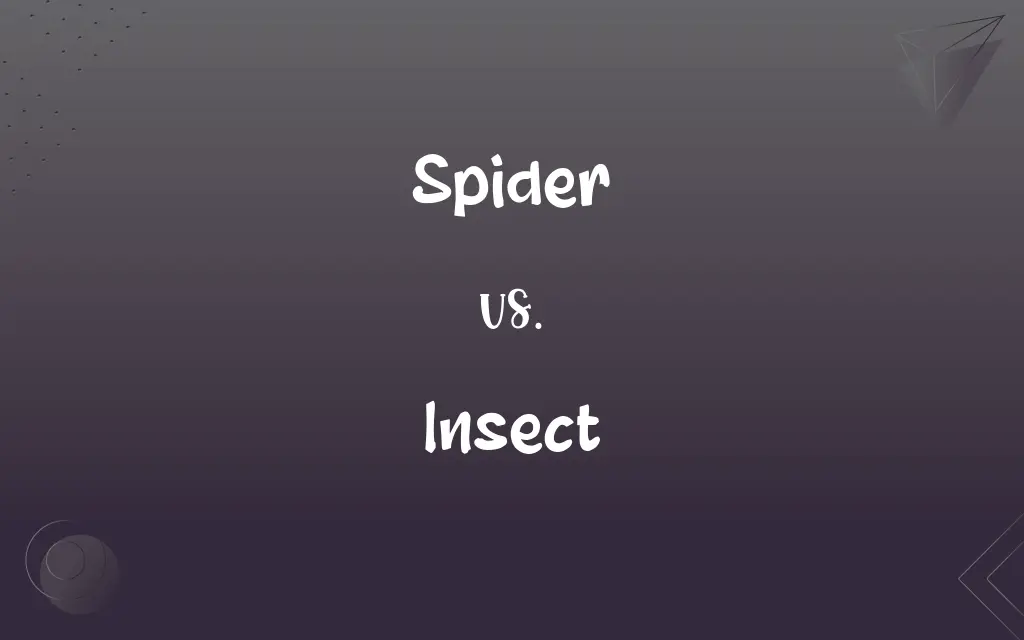Spider vs. Insect: What's the Difference?
Edited by Aimie Carlson || By Harlon Moss || Updated on October 19, 2023
Spiders are arachnids with 8 legs; insects are hexapods with 6 legs and 3 body segments.

Key Differences
Spiders are members of the arachnid class, distinguished by their eight legs. In contrast, insects belong to the insecta class and are recognized by their six legs. Both spiders and insects play crucial roles in the ecosystem, often acting as predators or prey.
A significant distinction between spiders and insects is their body segmentation. While spiders have two primary body segments - the cephalothorax and the abdomen, insects possess three distinct sections: the head, thorax, and abdomen. This distinction in body parts often aids in their easy identification.
In terms of habitat and behavior, both spiders and insects exhibit a wide range. However, all spiders are predators, primarily feeding on other small creatures, including insects. Insects, on the other hand, have diverse diets ranging from plant-based, like those of butterflies, to flesh-based, as seen in carnivorous beetles.
The reproductive methods of spiders and insects also vary. Spiders typically lay eggs encapsulated in silk sacs. Insects may lay eggs, but their development can encompass multiple stages, including larvae and pupa before reaching adulthood. It's interesting to note that while both groups can produce silk, spiders excel in this ability, using it for various purposes like web-making and egg protection.
While many insects can fly thanks to their wings, no spiders possess this ability. Instead, some young spiders can 'balloon', using silk threads to be carried by the wind for dispersal. This method, however, doesn't equate to the controlled flight exhibited by insects.
ADVERTISEMENT
Comparison Chart
Number of Legs
8 legs.
6 legs.
Body Segments
2 segments (cephalothorax and abdomen).
3 segments (head, thorax, and abdomen).
Dietary Behavior
Predominantly predators.
Varied (herbivores, carnivores, omnivores).
Reproduction
Lay eggs in silk sacs.
Development can include larvae and pupa stages.
Ability to Fly
Cannot fly.
Many can fly.
ADVERTISEMENT
Spider and Insect Definitions
Spider
An eight-legged arachnid.
The spider spun a delicate web in the corner of the room.
Insect
A six-legged arthropod with three body segments.
The insect buzzed around the flower before landing.
Spider
Creature known for venomous bites in some species.
The black widow is a spider notorious for its potent venom.
Insect
Member of the hexapod class, many with wings.
The colorful insect took flight, catching the sunlight beautifully.
Spider
Arthropod with two main body segments.
Observing the spider closely, its cephalothorax and abdomen were evident.
Insect
Organism undergoing metamorphosis in many species.
The insect transformed from a caterpillar into a butterfly.
Spider
A predator known for its silk-producing abilities.
The spider captured its prey using a sticky web.
Insect
Arthropod often found in various roles in ecosystems.
The insect pollinated the flowers, aiding in their reproduction.
Spider
Organism exhibiting 'ballooning' behavior for dispersal.
The young spider released a silk thread, letting the wind carry it away.
Insect
Creature with diverse diets and habitats.
The insect chewed on the leaf, extracting nutrients.
Spider
Any of numerous arachnids of the order Araneae, having a body divided into a cephalothorax and an abdomen, eight legs, two chelicerae that bear venom glands, and two or more spinnerets that produce the silk used to make nests, cocoons, or webs for trapping insects.
Insect
Any of numerous arthropod animals of the class Insecta, having an adult stage characterized by three pairs of legs and a body segmented into head, thorax, and abdomen and usually having one or two pairs of wings. Insects include the flies, crickets, mosquitoes, beetles, butterflies, and bees.
Spider
One that resembles a spider, as in appearance, character, or movement.
Insect
Any of various other small, chiefly arthropod animals, such as spiders, centipedes, or ticks, usually having many legs. Not in scientific use.
FAQs
Are all spiders venomous?
Most spiders produce venom, but only a few species have venom harmful to humans.
What is a spider?
A spider is an arthropod with eight legs, belonging to the order Araneae in the class Arachnida.
Do spiders have antennae?
No, spiders do not have antennae.
How many eyes do spiders typically have?
Most spiders have eight eyes, but some species have fewer.
How many body parts do spiders have?
the cephalothorax (fused head and thorax) and the abdomen.
What is the largest spider in the world?
The Goliath birdeater (Theraphosa blondi) is considered the largest spider by mass and body length.
Do insects have antennae?
Yes, insects typically have one pair of antennae.
What do insects eat?
Insects have a diverse diet, including plant material, nectar, other insects, blood, and more.
Are all insects pests?
No, while some insects are pests, many are beneficial, playing vital roles in pollination, decomposition, and controlling other pests.
How do spiders produce silk?
Spiders produce silk from specialized glands in their abdomen called spinnerets.
What is an insect?
An insect is a small arthropod with six legs, typically having three distinct body parts: head, thorax, and abdomen.
What is the smallest insect?
The smallest known insects are fairyflies, tiny wasps that can be less than 0.2 mm long.
How do insects breathe?
Insects breathe through tiny tubes called tracheae that transport oxygen directly to their tissues.
How do spiders reproduce?
Spiders reproduce through the transfer of sperm from the male to the female using specialized appendages called pedipalps.
Do all spiders weave webs?
No, not all spiders weave webs; some are hunters or burrowers.
How many wings do insects have?
Most adult insects have two pairs of wings, though some species may have one pair or none at all.
How many known species of insects are there?
There are over a million described species of insects, with many more yet to be discovered.
Are spiders insects?
No, spiders are arachnids, not insects.
What do spiders primarily eat?
Spiders are mostly carnivorous and eat insects, other spiders, and occasionally small vertebrates.
How many legs do insects have?
Insects have six legs.
About Author
Written by
Harlon MossHarlon is a seasoned quality moderator and accomplished content writer for Difference Wiki. An alumnus of the prestigious University of California, he earned his degree in Computer Science. Leveraging his academic background, Harlon brings a meticulous and informed perspective to his work, ensuring content accuracy and excellence.
Edited by
Aimie CarlsonAimie Carlson, holding a master's degree in English literature, is a fervent English language enthusiast. She lends her writing talents to Difference Wiki, a prominent website that specializes in comparisons, offering readers insightful analyses that both captivate and inform.































































